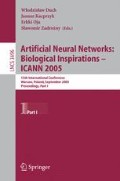Abstract
We studied the emergence of cell assemblies out of a locally connected random network of 10,000 integrate-and-fire units distributed on a 100×100 2D lattice. The network was composed of 80% excitatory and 20% inhibitory units with balanced excitatory/inhibitory synaptic weights. Excitatory–excitatory synapses were modified according to a spike-timing-dependent synaptic plasticity (STDP) rule associated with synaptic pruning. In presence of a stimulus and with independent random background noise (5 spikes/s), we observed that after 5·105 ms of simulated time, about 8% of the exc–exc connections remained active and were reinforced with respect to the initial strength. The projections that remained active after pruning tended to be oriented following a feed-forward converging–diverging pattern. This result suggests that topologies compatible with synfire chains may appear during unsupervised pruning processes.
Access this chapter
Tax calculation will be finalised at checkout
Purchases are for personal use only
Preview
Unable to display preview. Download preview PDF.
References
Rakic, P., Bourgeois, J.P., Eckenhoff, M.F., Zecevic, N., Goldman-Rakic, P.S.: Concurrent overproduction of synapses in diverse regions of the primate cerebral cortex. Science 232, 232–235 (1986)
Bi, G.Q., Poo, M.M.: Synaptic modifications in cultured hippocampal neurons: dependence on spike timing, synaptic strength, and postsynaptic cell type. J. Neurosci. 18, 10464–10472 (1998)
Karmarkar, U.R., Buonomano, D.V.: A model of spike-timing dependent plasticity: one or two coincidence detectors? J. Neurophysiol. 88, 507–513 (2002)
Chechik, G., Meilijson, I., Ruppin, E.: Neuronal Regulation: A Mechanism for Synaptic Pruning During Brain Maturation. Neural Computation 11, 2061–2080 (1999)
Song, S., Abbott, L.F.: Cortical Development and Remapping through Spike Timing-Dependent Plasticity. Neuron 32, 339–350 (2001)
Eriksson, J., Torres, O., Mitchell, A., Tucker, G., Lindsay, K., Rosenberg, J., Moreno, J.-M., Villa, A.E.P.: Spiking Neural Networks for Reconfigurable POEtic Tissue. In: Tyrrell, A.M., Haddow, P.C., Torresen, J. (eds.) ICES 2003. LNCS, vol. 2606, pp. 165–173. Springer, Heidelberg (2003)
Iglesias, J., Eriksson, J., Grize, F., Tomassini, M., Villa, A.E.P.: Dynamics of Pruning in Simulated Large-Scale Spiking Neural Networks. Biosystems 79, 11–20 (2005)
Abeles, M.: Corticonics: Neural Circuits of the Cerebral Cortex. Cambridge University Press, Cambridge (1991)
Tetzlaff, T., Morrison, A., Geisel, T., Diesmann, M.: Consequences of realistic netowrk size on the stability of embedded synfire chains. Neurocomputing 58-60, 117–121 (2004)
Author information
Authors and Affiliations
Editor information
Editors and Affiliations
Rights and permissions
Copyright information
© 2005 Springer-Verlag Berlin Heidelberg
About this paper
Cite this paper
Iglesias, J., Eriksson, J., Pardo, B., Tomassini, M., Villa, A.E.P. (2005). Emergence of Oriented Cell Assemblies Associated with Spike-Timing-Dependent Plasticity. In: Duch, W., Kacprzyk, J., Oja, E., Zadrożny, S. (eds) Artificial Neural Networks: Biological Inspirations – ICANN 2005. ICANN 2005. Lecture Notes in Computer Science, vol 3696. Springer, Berlin, Heidelberg. https://doi.org/10.1007/11550822_21
Download citation
DOI: https://doi.org/10.1007/11550822_21
Publisher Name: Springer, Berlin, Heidelberg
Print ISBN: 978-3-540-28752-0
Online ISBN: 978-3-540-28754-4
eBook Packages: Computer ScienceComputer Science (R0)

